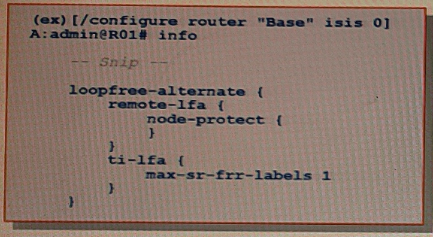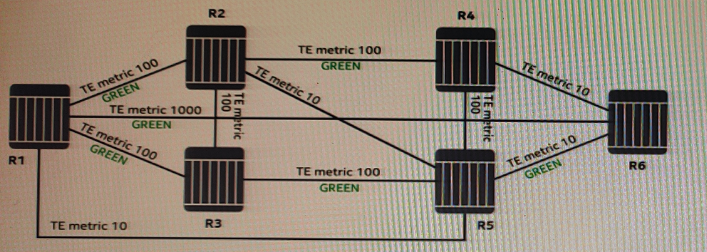Nokia Segment Routing 4A0-116 Exam Practice Test
The exhibit shows the fast re-route configuration on router R1, in which both R-LFA and TI-LFA have been enabled. Assume that there are multiple potential backup paths for a given prefix. Which of the following options will router R1 use?

Answer : D
The exhibit shows that both R-LFA and TI-LFA have been enabled on router R1. R-LFA (Remote Loop-Free Alternate) is a method that is used to protect the active segment of a tunnel, and it allows the router to find a backup path that coincides with the path that will become active after IGP reconvergence. TI-LFA (Topology Independent LFA) is a method that is used to protect an end-to-end multi-segment tunnel, it allows the router to find a backup path that does not rely on the IGP topology, but on the segment routing topology.
With R-LFA and TI-LFA enabled, router R1 will use a D-LFA (Dual-Loop-Free Alternate) path, which is a combination of both R-LFA and TI-LFA, this path will coincide with the path after IGP re-convergence.
A standard LFA, R-LFA, and D-LFA which do not coincide with the path after IGP re-convergence are not the options.
Which of the following statements about primary and secondary SR-TE LSP paths is FALSE?
Answer : B
Typically, in SR-TE, only two paths can be configured for a given SR-TE LSP: primary path and secondary path. The primary path is used for normal traffic forwarding, and the secondary path is used as a backup in case the primary path fails. Only one LSP path forwards the traffic at any time.
Examine the exhibit.

An LSP is being configured to start at R1 and end at R6 using local CSPF. The LSP has the following constraints. Include admin-group GREEN, use the TE metric and hop-limit 3. What routers will be included in the LSP path?
Answer : C
In the context of a network that includes a Path Computation Element (PCE), what is a PCC-initiated LSP?
Answer : D
A PCC-initiated LSP is an LSP that is established and controlled by the PCC (Path Computation Client) which is typically a head-end router. The PCC sends LSP setup and teardown requests to the PCE and also reports the existence and state of the LSPs to the PCE. The PCE then uses this information to perform path computation and to monitor the state of the LSPs.
Which of the following is NOT one of the main goals of traffic engineering?
Answer : D
Which of the following statements about Multi-Protocol Label Switching networks is FALSE?
Answer : D
The data is transparently carried from end to end: This statement is not true, MPLS does not provide data transparency, which means that the data is not carried unmodified from end to end. MPLS uses labels to forward data, so the original IP packets are encapsulated in new MPLS packets, and the original IP headers are not visible at the egress LSR.
Examine the exhibit. Based upon the configuration, which routers will the LSP go through?

Answer : C